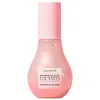What's inside
What's inside
 Key Ingredients
Key Ingredients

 Benefits
Benefits

 Concerns
Concerns

 Ingredients Side-by-side
Ingredients Side-by-side

Water
Skin ConditioningPropanediol
SolventGlycereth-26
HumectantGlycerin
HumectantNiacinamide
Smoothing2,3-Butanediol
Humectant1,2-Hexanediol
Skin ConditioningCetyl Ethylhexanoate
EmollientCitrullus Lanatus Fruit Extract
Skin ConditioningSodium Hyaluronate
HumectantEclipta Prostrata Extract
Skin ConditioningMelia Azadirachta Leaf Extract
Skin ConditioningPolyglyceryl-3 Methylglucose Distearate
EmulsifyingTromethamine
BufferingGlyceryl Stearate
EmollientCarbomer
Emulsion StabilisingAcrylates/C10-30 Alkyl Acrylate Crosspolymer
Emulsion StabilisingEthylhexylglycerin
Skin ConditioningXanthan Gum
EmulsifyingPolyquaternium-51
Skin ConditioningMoringa Oleifera Seed Oil
EmollientParfum
MaskingBenzyl Benzoate
AntimicrobialWater, Propanediol, Glycereth-26, Glycerin, Niacinamide, 2,3-Butanediol, 1,2-Hexanediol, Cetyl Ethylhexanoate, Citrullus Lanatus Fruit Extract, Sodium Hyaluronate, Eclipta Prostrata Extract, Melia Azadirachta Leaf Extract, Polyglyceryl-3 Methylglucose Distearate, Tromethamine, Glyceryl Stearate, Carbomer, Acrylates/C10-30 Alkyl Acrylate Crosspolymer, Ethylhexylglycerin, Xanthan Gum, Polyquaternium-51, Moringa Oleifera Seed Oil, Parfum, Benzyl Benzoate
Ananas Sativus Fruit Extract
Skin ConditioningButylene Glycol
HumectantPropanediol
SolventWater
Skin Conditioning3-O-Ethyl Ascorbic Acid
Skin ConditioningDimethicone
EmollientAscorbic Acid
AntioxidantLactic Acid
BufferingSodium Hyaluronate
HumectantChamomilla Recutita Flower Extract
MaskingAloe Barbadensis Leaf Juice
Skin ConditioningSqualane
EmollientTocopheryl Acetate
AntioxidantPortulaca Oleracea Extract
Skin ConditioningCarthamus Tinctorius Seed Extract
Skin ConditioningHexylresorcinol
AntimicrobialArginine
MaskingEthylhexylglycerin
Skin ConditioningCaprylic/Capric Triglyceride
MaskingXanthan Gum
EmulsifyingCaprylyl Glycol
EmollientPentylene Glycol
Skin ConditioningDimethicone Crosspolymer
Emulsion StabilisingParfum
MaskingAnanas Sativus Fruit Extract, Butylene Glycol, Propanediol, Water, 3-O-Ethyl Ascorbic Acid, Dimethicone, Ascorbic Acid, Lactic Acid, Sodium Hyaluronate, Chamomilla Recutita Flower Extract, Aloe Barbadensis Leaf Juice, Squalane, Tocopheryl Acetate, Portulaca Oleracea Extract, Carthamus Tinctorius Seed Extract, Hexylresorcinol, Arginine, Ethylhexylglycerin, Caprylic/Capric Triglyceride, Xanthan Gum, Caprylyl Glycol, Pentylene Glycol, Dimethicone Crosspolymer, Parfum
 Reviews
Reviews

Ingredients Explained
These ingredients are found in both products.
Ingredients higher up in an ingredient list are typically present in a larger amount.
Ethylhexylglycerin (we can't pronounce this either) is commonly used as a preservative and skin softener. It is derived from glyceryl.
You might see Ethylhexylglycerin often paired with other preservatives such as phenoxyethanol. Ethylhexylglycerin has been found to increase the effectiveness of these other preservatives.
Parfum is a catch-all term for an ingredient or more that is used to give a scent to products.
Also called "fragrance", this ingredient can be a blend of hundreds of chemicals or plant oils. This means every product with "fragrance" or "parfum" in the ingredients list is a different mixture.
For instance, Habanolide is a proprietary trade name for a specific aroma chemical. When used as a fragrance ingredient in cosmetics, most aroma chemicals fall under the broad labeling category of “FRAGRANCE” or “PARFUM” according to EU and US regulations.
The term 'parfum' or 'fragrance' is not regulated in many countries. In many cases, it is up to the brand to define this term.
For instance, many brands choose to label themselves as "fragrance-free" because they are not using synthetic fragrances. However, their products may still contain ingredients such as essential oils that are considered a fragrance by INCI standards.
One example is Calendula flower extract. Calendula is an essential oil that still imparts a scent or 'fragrance'.
Depending on the blend, the ingredients in the mixture can cause allergies and sensitivities on the skin. Some ingredients that are known EU allergens include linalool and citronellol.
Parfum can also be used to mask or cover an unpleasant scent.
The bottom line is: not all fragrances/parfum/ingredients are created equally. If you are worried about fragrances, we recommend taking a closer look at an ingredient. And of course, we always recommend speaking with a professional.
Learn more about ParfumPropanediol is an all-star ingredient. It softens, hydrates, and smooths the skin.
It’s often used to:
Propanediol is not likely to cause sensitivity and considered safe to use. It is derived from corn or petroleum with a clear color and no scent.
Learn more about PropanediolSodium Hyaluronate is hyaluronic acid's salt form. It is commonly derived from the sodium salt of hyaluronic acid.
Like hyaluronic acid, it is great at holding water and acts as a humectant. This makes it a great skin hydrating ingredient.
Sodium Hyaluronate is naturally occurring in our bodies and is mostly found in eye fluid and joints.
These are some other common types of Hyaluronic Acid:
Learn more about Sodium HyaluronateWater. It's the most common cosmetic ingredient of all. You'll usually see it at the top of ingredient lists, meaning that it makes up the largest part of the product.
So why is it so popular? Water most often acts as a solvent - this means that it helps dissolve other ingredients into the formulation.
You'll also recognize water as that liquid we all need to stay alive. If you see this, drink a glass of water. Stay hydrated!
Learn more about WaterXanthan gum is used as a stabilizer and thickener within cosmetic products. It helps give products a sticky, thick feeling - preventing them from being too runny.
On the technical side of things, xanthan gum is a polysaccharide - a combination consisting of multiple sugar molecules bonded together.
Xanthan gum is a pretty common and great ingredient. It is a natural, non-toxic, non-irritating ingredient that is also commonly used in food products.
Learn more about Xanthan Gum